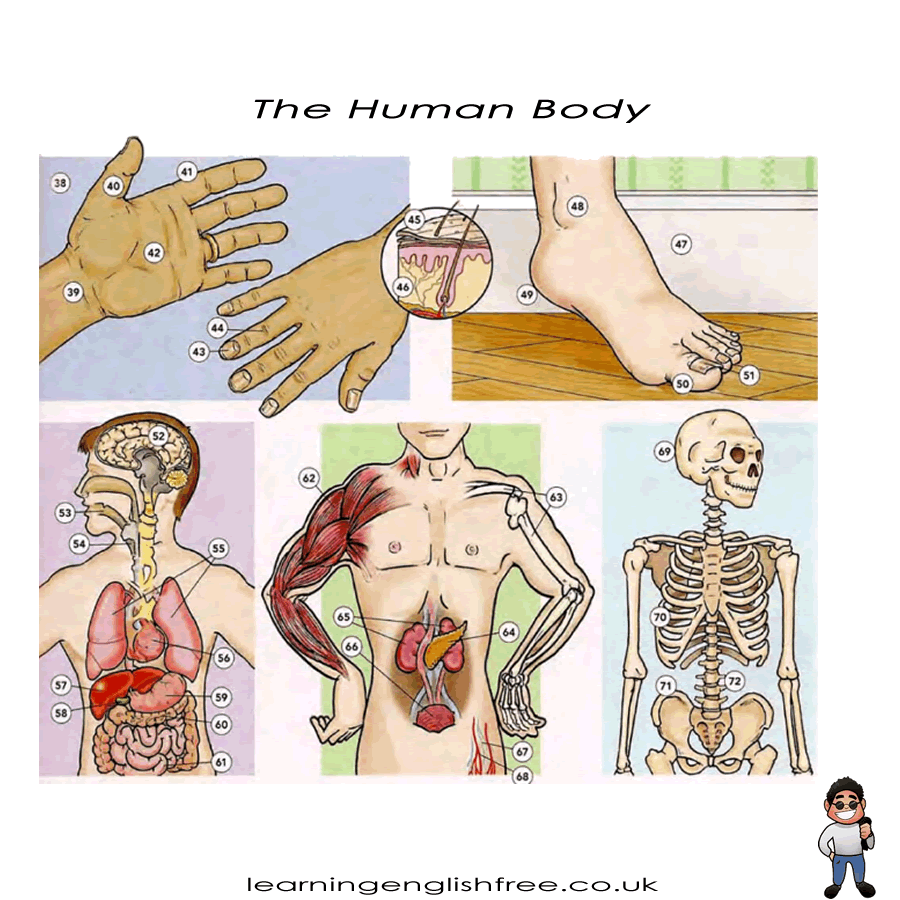
Advanced English: Organs, Limbs, and Bones
|
38 hand 39 wrist 40 thumb 41 finger 42 palm 43 fingernail 44 knuckle 45 skin |
46 nerve 47 foot 48 ankle 49 heel 50 toe 51 toenail 52 brain 53 throat |
54 esophagus 55 lungs 56 heart 57 liver 58 gallbladder 59 stomach 60 large intestine 61 small intestine |
62 muscles 63 bones 64 pancreas 65 kidneys 66 bladder 67 veins 68 arteries
|
69 skull 70 ribcage 71 pelvis 72 spinal column/ spinal cord
|
Continuing Our Journey: Learning More Body Parts in English
Welcome back to the second part of our body parts lesson in English! This time, we will explore more specific parts, including organs and limbs. Understanding these terms is crucial for describing more detailed body functions and anatomy in English. Let’s dive in!
Body Parts and Usage in Sentences
- Hand: The end part of the arm used for holding things.
- "She waved her hand in greeting."
- Wrist: The joint between the hand and the arm.
- "He wore a watch on his wrist."
- Thumb: The short, thick finger on the side of the hand.
- "She gave a thumbs up for approval."
- Finger: One of the five digits on the hand.
- "He pointed with his finger."
- Palm: The inner part of the hand.
- "She held the coin in her palm."
- Fingernail: The hard covering at the end of the fingers.
- "She painted her fingernails red."
- Knuckle: The joints in the fingers.
- "He cracked his knuckles nervously."
- Skin: The outer layer of the body.
- "Her skin was soft and smooth."
- Nerve: A fibre that sends signals to and from the brain.
- "He had the nerve to speak up."
- Foot: The lower part of the leg is used for standing and walking.
- "She tapped her foot to the music."
- Ankle: The joint connecting the foot and the leg.
- "He twisted his ankle playing soccer."
- Heel: The back part of the foot below the ankle.
- "She wore shoes with high heels."
- Toe: One of the digits on the foot.
- "He stubbed his toe on the door."
- Toenail: The hard covering at the end of the toes.
- "He cut his toenails short."
- Brain: The organ in the head that controls the body.
- "The brain is capable of amazing things."
- Throat: The front part of the neck.
- "She cleared her throat before speaking."
- Esophagus: The tube that carries food from the throat to the stomach.
- "Food passes down the oesophagus when you swallow."
- Lungs: The organs used for breathing.
- "The lungs fill with air when you breathe in."
- Heart: The organ that pumps blood throughout the body.
- "His heart was beating fast."
- Liver: The organ that detoxifies and processes nutrients.
- "The liver plays a vital role in digestion."
- Gallbladder: The small organ that stores bile for digestion.
- "Gallstones can form in the gallbladder."
- Stomach: The organ where food is broken down.
- "She had a stomachache."
- Large Intestine: The part of the intestines where water is absorbed.
- "The large intestine is important for water absorption."
- Small Intestine: The part where most digestion and absorption occur.
- "Nutrients are absorbed in the small intestine."
- Muscles: The tissues that contract to move parts of the body.
- "He flexed his muscles."
- Bones: The complex structures that form the skeleton.
- "She broke a bone in her hand."
- Pancreas: The organ that helps with digestion and regulates blood sugar.
- "The pancreas produces insulin."
- Kidneys: The organs that filter blood and produce urine.
- "The kidneys are essential for filtering waste."
- Bladder: The organ that stores urine.
- "He needed to empty his bladder."
- Veins: The blood vessels that carry blood towards the heart.
- "The nurse found a vein for the injection."
- Arteries: The blood vessels that carry blood away from the heart.
- "Arteries carry oxygen-rich blood."
- Skull: The bone structure that forms the head.
- "The skull protects the brain."
- Ribcage: The set of bones that protect the chest organs.
- "The ribcage shields the lungs and heart."
- Pelvis: The set of bones in the lower part of the torso.
- "The pelvis supports the body's weight."
- Spinal Column/Spinal Cord: The central support of the body and its main pathway of nerves.
- "The spinal cord connects the body to the brain."
We've expanded our knowledge of body parts in English, covering everything from limbs to internal organs. This understanding is critical for describing detailed physical aspects and health-related topics.
